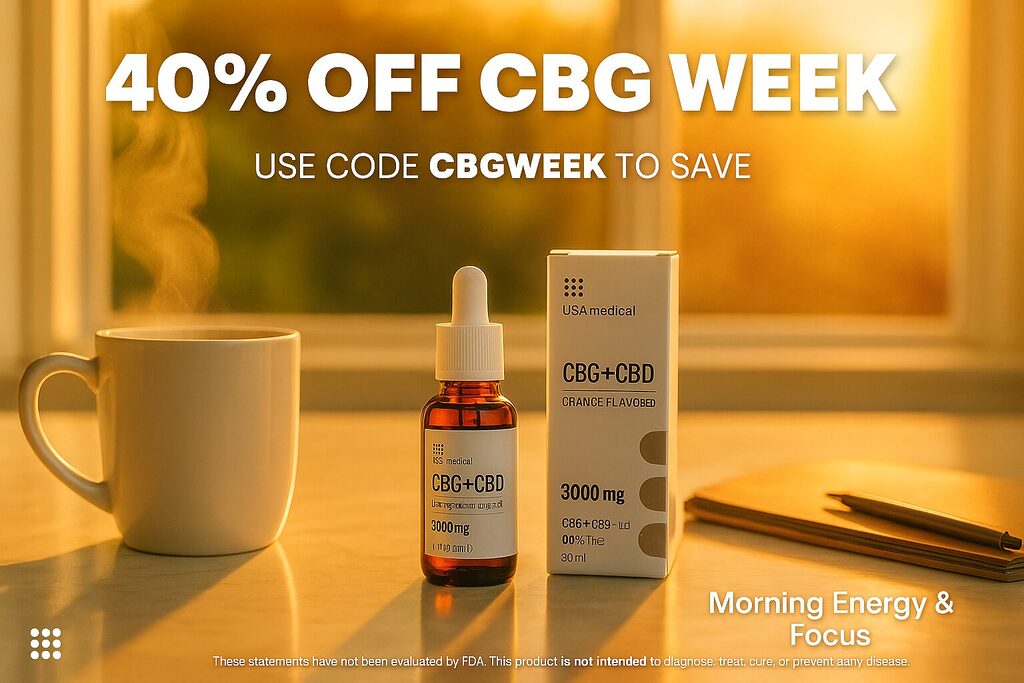
Breaking: CBG Week Starts Today, 50% Off Through Sunday, Sep 14
Save 50% on USA Medical CBG this week. Use code
By Jake Crossman (CNC-NASM), Nutrition Specialist; Holistic Health Coach; Managing Partner, USA Medical
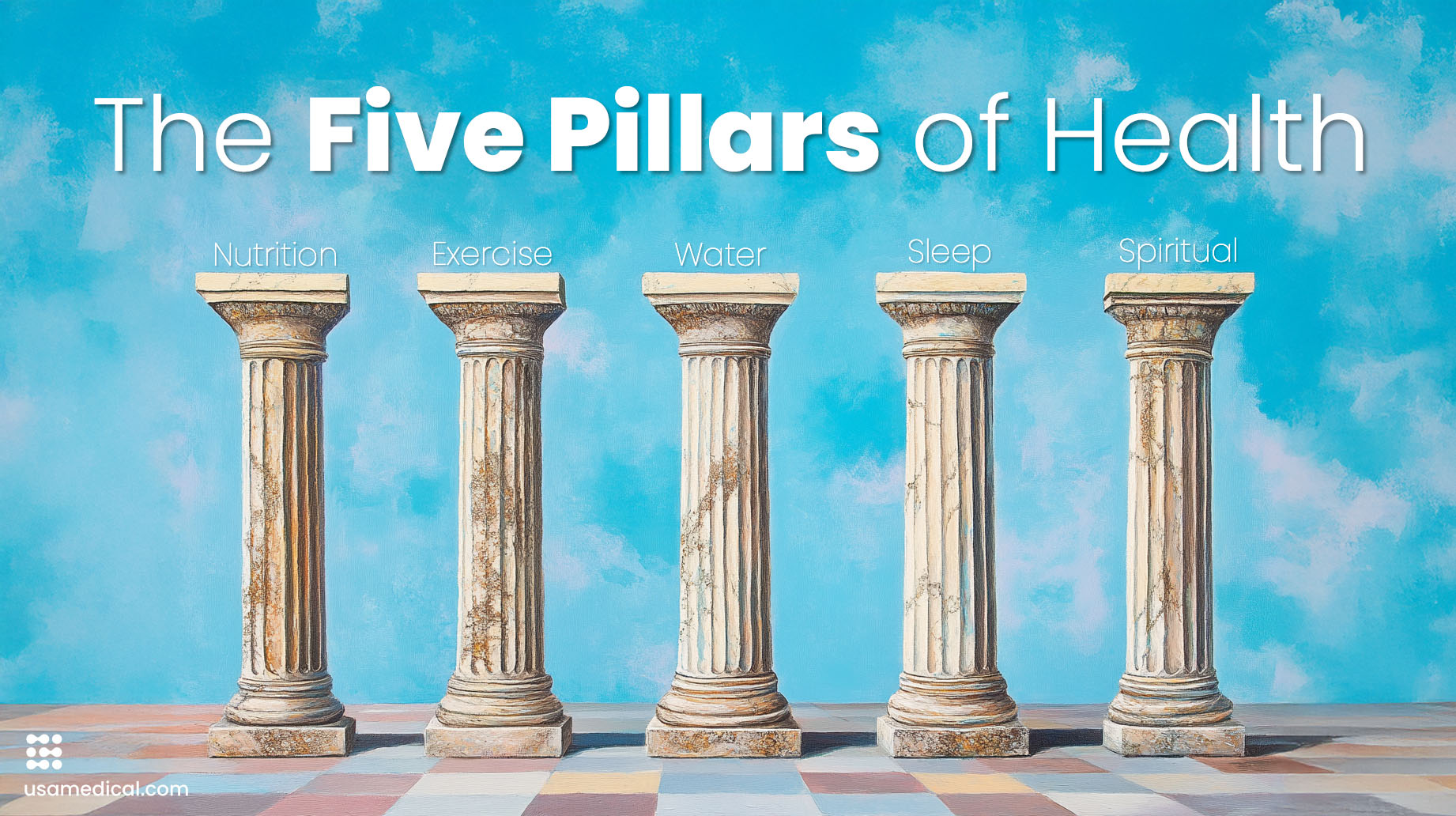
Welcome to Health Academy, USA Medical’s premier health education database. Our goal is to simplify health – making it easy for everyone to be healthy.
At USA Medical, we believe health should be simple. In fact, health should be so simple that it’s more difficult to be unhealthy than it is to be healthy.
However, modern-day health experts, doctors, and government-appointed health directors have drastically over-complicated health for you to rely on their “expertise” in order to be healthy. And yet, we are the most unhealthy society in human history. Chronic disease, chronic pain, chronic obesity, and every other version of the word chronic are at an all-time high.
We believe we can easily and quickly simplify health to radically improve the health of everyone who reads this. To live healthy is to live normally.
Your body’s normal tendency is towards health, but it’s the things you don’t know about health that cause you to fall into the traps of modern disease and unhealthy lifestyles.
At USA Medical, we believe in the Five Pillars of Health:
Now, spiritual health does not mean religion. In fact, it’s quite the opposite.
Your spirit is the spirit of the human—the will to live, the will to succeed, and the will to do better. The category of spiritual health is the category of discipline, the category of goal-setting, and the category of the drive that brought you to read this.
So don’t worry; everything we speak about here is research-backed, scientific, and measurable—but most importantly, easy.
Today, we’re going to jump right into the Five Pillars of Health to get you excited and ready to live your healthiest life.
No paywalls, no waiting, no nonsense.
Right here at Health Academy by USA Medical, we are giving you the playbook for free—because the healthier you are, the better we all become.
We’ll add more detailed articles about specific aspects of health as time passes. But today, let’s start with an overview of the Five Pillars of Health to show you how simple being healthy really is.
Your nutrition, or the food you eat, is your life’s building blocks. Everything about you is food. From the food your mother ate while you were in the womb, to the nursing milk you received as a baby, to the first slice of pizza you ate—every bite of food becomes you.
Your body undergoes many incredible processes to digest and break down food into its individual components. Then, it reassembles these components as organ tissue, brain tissue, skin, hair, nails, and everything else.
So nutrition is the first and most important health category because nutrition is you.
Let’s break nutrition down into its three main categories:
Your body is made up exclusively of protein and fat, while carbohydrates are the fuel behind many energy-driven processes. The unit of measurement we use to define energy are calories.
It’s important to understand that calories are not these things that make us fat, but specifically a unit of measurement to determine energy.
Now, let’s talk about each of these categories so you can easily understand how they affect your body.
Protein is the most important category of nutrition.
For centuries, humans have hunted and gathered as much protein as possible to survive. Protein is broken down into amino acids, which your body reassembles into every tissue, organ, and system within your body.
Protein is what your body uses to heal, repair, and recover. Protein is what your body needs to grow and to be strong.
Many people were taught the food pyramid as a way to eat healthy, but the food pyramid was actually made up by corporations who wanted to sell more carbohydrate-rich food. (Learn more about that here.)
The most important foundation of a healthy nutrition plan is protein.
If you only eat protein every day for the rest of your life, you might actually be the healthiest person in the world.
That’s not to say that fat and carbs aren’t important—fat carries vitamins and minerals, and carbohydrates are simple energy. But carbohydrates do not build your body – they do not improve your health.
In fact, many carbohydrates might negatively impact your health—but we’ll get to that later.
The point is this: the more protein you eat, the healthier you are.
If every time you felt hungry, you first ate protein, then backfilled with fat and carbs, you would be nutritionally healthier than ever before. (Backfill means adding fats and carbohydrates to your diet only after you’ve met your daily protein requirement.)
Your Protein Goal: Your protein goal should be at minimum 0.5 grams of protein for every pound of body weight. For example:
If you’re not sure how much protein to eat, weigh yourself, cut it in half, and that’s the minimum amount of protein you should eat every day.
Fat is an incredible energy source that your body can easily use through a special process called ketogenesis.
Incredibly, while tumors and cancer cells require glucose (simple carbohydrates) to survive, your body does not, which means using fat for energy is the healthiest, most effective way to starve disease in your body.
Even more incredibly, every gram of carbohydrates equals 4 kcals of energy (4 calories of energy), while every gram of fat equals 7 kcals of energy (7 calories of energy).
That means every gram of fat you eat actually gives you 3 more calories of potential energy than every gram of carbs, making fat the most effective source of fuel for your body.
While your body can also break down protein into energy, it’s not as efficient or recommended. That means eating protein with fat is the best way to build your body and give it the energy it needs.
While many health experts and doctors argue that ketogenesis is not a natural state for the human body, that’s simply not true. Your body easily makes ketones to use fat for energy and starve off disease. Let’s discuss how this process works:
Ketogenesis is the process your body uses to convert fat into ketones, which are simple energy molecules.
When you eat fewer carbohydrates, your body runs out of glucose (sugar) to burn for energy. So, instead of shutting down, your body switches to burning fat and produces ketones in the liver to fuel your muscles, brain, and organs.
This process is completely natural and happens every time you fast, skip a meal or reduce your carb intake. It’s your body’s built-in plan to survive and thrive without carbohydrates.
The best part? Cancer cells and tumors cannot use ketones for energy—they need glucose to survive. So, by switching your body to fat for fuel, you can help starve diseases while fueling your body with clean, long-lasting energy.
Healthy fats are the most nutrient-dense thing you can eat, loaded with essential vitamins and minerals.
For example, eating a fatty ribeye steak provides:
Eating fat-rich foods like steak, eggs, salmon, and avocados means you’re not just getting energy—you’re fueling your body with essential nutrients to stay healthy and thrive.
While non-essential, carbohydrates are easily used by the body for simple energy. Unlike protein and fat, they are not necessary for survival.
While carbohydrates are delicious—and everyone loves foods like bread, pie, cake, brownies, pasta, and beer—they do not build your body or improve long-term health.
That doesn’t mean carbohydrates are bad. Healthy people can enjoy carbs, and if you’re exercising regularly, carbs are a quick source of energy.
However, when it comes to building a foundation of health, focusing on protein and fat while eliminating carbohydrates drastically improves your overall health.
By removing carbohydrates, you reduce spikes in blood sugar, lower inflammation, and train your body to burn fat for energy instead of sugar. This improves heart health, cholesterol, insulin tolerance, and hundreds of other processes in your body,
Once your body adapts to a low-carb lifestyle, you’ll feel more energized, focused, and healthier than ever before.
Once you’re healthy and your body is working it’s best, you can add carbs back into your diet in the form of:
Unlike processed carbs like bread, pasta, and desserts, these carbohydrates come with added nutritional value, which can help prevent severe spikes in blood sugar that lead to energy crashes.
We’re not advising against carbohydrates in general. In fact, if you’re active and healthy, carbohydrates can be a great tool for quick energy and recovery.
However, the point is this: carbohydrates are not essential if you’re eating plenty of protein and fat to fuel your energy and nutritional needs.
Focus first on protein and fat to build a strong foundation of health. Then, once you’re thriving, you can enjoy healthy carbs like fruits, vegetables, and honey as an added bonus—not as a necessity.
Exercise is a fundamental need of the human body, but it doesn’t have to mean bench pressing 220 pounds in a crowded gym.
Exercise—or work—is simply the action of doing something with your body. Our bodies are not meant to be at rest. They are meant to be in motion.
Humans are built for endurance. Unlike most animals, humans have unmatched stamina and endurance. For example, while a cheetah can sprint at 70 miles per hour, it can only maintain that speed for 30 seconds before it overheats and collapses.
Humans, however, can move for hours. Ancient hunters used this advantage to outrun prey not by speed but by persistence, wearing down animals until they collapsed from exhaustion.
This incredible endurance is proof that our bodies are designed for movement.
When getting started, the best exercise for your body is low-impact aerobic exercise, which uses oxygen to fuel your muscles and keep you going.
There are two main types of exercise: aerobic and anaerobic. Let’s define each so you better understand how they work.
Anaerobic exercise is short, intense, and explosive. It relies on stored energy (glycogen) instead of oxygen and fat to fuel your muscles.
This means anaerobic activities are powerful but short-lived. Here are a few examples of anaerobic exercises you can try:
These anaerobic activities are highly effective for building strength and endurance but must be performed with proper form and pacing.
Anaerobic exercise offers several key benefits that make it a beneficial part of any workout routine:
By incorporating anaerobic exercises into your routine, you can maximize strength, increase stamina, and build lean muscle.
While anaerobic exercise is highly effective, it does come with some challenges to keep in mind:
Understanding the pros and cons allows you to balance intensity with recovery so you can make the most of anaerobic training without overdoing it.
Aerobic exercise is steady, sustained movement that uses oxygen and fat to fuel your body. It’s lower intensity but longer-lasting than anaerobic exercise.
Examples of aerobic exercises include activities that are accessible and easy to incorporate into daily life:
These forms of aerobic exercise help build cardiovascular health and endurance without requiring extreme effort.
Aerobic exercise offers long-lasting benefits for your heart, lungs, and mind, including:
Adding aerobic activity to your routine is one of the best ways to support your long-term health and well-being.
If you’re new to exercising, the best place to start is with low-impact movements that are simple, effective, and easy to recover from. Here are some of the best low-impact exercises:
Starting with low-impact exercises helps you build consistency without overwhelming your body.
So, why start here? Low-impact exercises offer several advantages for beginners and experienced exercisers alike. They’re always available. You can do them at home, in a park, or anywhere. They’re low-impact. They protect your joints and reduce injury risks. They’re high return. They improve strength, endurance, and flexibility quickly.
By starting with these foundational movements, you can establish a routine and build strength before advancing to more intense workouts.
Once you’ve built a foundation with simple, low-impact movements, you can take it to the next level with weight training. Weightlifting offers additional benefits that go beyond basic fitness, including building muscle mass to protect joints and boost metabolism.
Lifting heavier weights forces your body to adapt, grow, and get stronger. It’s not just about looking better—it’s about aging better, feeling stronger, and improving your overall health.
The point is—starting small is the key.
If you’re someone who doesn’t exercise, you can’t expect to become a gym guru overnight. And if you hit the gym every day for the next seven days, you’re more likely to burn out than build habits.
Start small. Go for a walk. Do some stretching. Try a yoga routine or bodyweight exercises. Then, gradually increase from there.
Once you start moving, your body will crave more. Exercise is addictive—and your body loves being addicted to healthy habits.
So get out there and start moving – because your body is designed for it!
Water is one of the Five Pillars of Health because it’s the most needed resource for your body on a daily basis. You can survive for weeks without food, but you can only survive for about 3 days without water.
That’s because water is one of the foundations for life. Your body is made up of ~70% water, and every process in your body—from digestion to detoxification—depends on it. Water is critically important to your body for:
So, because water is essential, quality matters. That means the type of water you drink greatly affects how your body uses it… and not all water is created equal.
At USA Medical, we advise against drinking tap water—and here’s why.
Most people assume that tap water in the United States is safe, but when you look deeper, the reality of tap water contamination is concerning. If you search your town’s local water report, you can find out what’s really in your tap water:
Go online and search your local town’s water report right now (just Google: “[Your Town] Tap Water Report”). You can quickly find out exactly what’s in your water supply, including all the contaminants and safety violations. Once you see the data, it’s clear—tap water isn’t worth the risk.
Once you ditch tap water, the question becomes: what water should I drink? Well, the world’s best water comes straight from natural springs—and here’s why.
Spring water is best due to natural minerals, natural electrolytes, and natural pH balance:
Remember, water isn’t just water. Pure water doesn’t hydrate your body alone. Your cells need the minerals and electrolytes found in natural spring water to absorb and use water effectively.
Think of it like this—water is the delivery system, but minerals are the fuel. Without minerals, your body struggles to use the water you drink.
Water is literally the most important part of your day. You can fast from food for days, but your body needs water every single day to survive. So, exactly how much water do you need?
If you’ve never tracked your water intake, you can’t know if you’re getting enough hydration. Follow these steps to get started tracking your daily water intake:
You don’t need to track your water intake forever. Once you understand how much water you drink, you’ll have a stronger intuition about your hydration. But remember, your body can’t function properly without water.
When you’re dehydrated, you’re slower, more tired, foggy, and at higher risk for disease and inflammation.
Water isn’t just important—it’s essential.
Water is life. Drink more of it—and make sure it’s the best water possible.
Once you’re eating well, exercising regularly, and drinking enough water, sleep is the next key pillar of health.
Sleep is when your body recovers energy, detoxes, and repairs muscle and brain tissue. It’s one of the most important parts of your day, and we should all be getting between 7 and 9 hours of sleep per night.
Sleep is divided into three components: light sleep, deep sleep, and REM sleep. Each sleep cycle serves a specific purpose in recovery and your overall health. Let’s discuss these sleep phases in detail and provide actionable tips for improving each one.
Light sleep is the transition stage between being awake and entering deeper phases of sleep. During this phase, your body begins to relax, and your brainwaves slow down to prepare for deeper recovery.
Light sleep plays a critical role in helping your body and brain shift from wakefulness to restoration. Without sufficient light sleep, your body may struggle to enter the deeper stages of sleep needed for repair and detoxification. Light sleep:
These processes work together to help your body feel rested and prepare your brain for the deeper stages of sleep.
Tips to Improve Light Sleep:
To optimize light sleep, focus on relaxing your body and mind before bed:
By incorporating these simple strategies, you can help your body ease into light sleep faster and set the stage for deeper recovery.
Deep sleep, also called slow-wave sleep, is the most restorative phase of sleep. During this phase, your body repairs tissues, builds muscles, and detoxifies your brain.
Deep sleep is critical because it’s when your body undergoes physical repair, and your brain removes waste toxins. You may experience fatigue, poor recovery, and weakened immunity without enough deep sleep. Deep sleep:
These benefits make deep sleep essential for physical recovery and mental clarity during the day.
Tips to Improve Deep Sleep:
Since deep sleep is all about repair and recovery, prioritize nutrients and habits that support detoxification:
Making small adjustments to support your body’s repair processes can significantly improve your overnight recovery.
Rapid Eye Movement (REM) sleep is when you experience dreams and mental recovery. Like being awake, Your brain activity increases, but your body remains paralyzed to prevent you from acting out dreams.
REM sleep is critical for brain function, emotional balance, and problem-solving. It also strengthens memories and enhances creativity. REM sleep:
REM sleep is even more critical than deep sleep, especially for mental health and emotional resilience.
Tips to Improve REM Sleep:
To improve REM sleep, focus on reducing stress and calming your mind:
Make stress relief a priority before bed to create a calm bedtime routine that helps your mind prepare for its best possible REM sleep.
Creating the right physical environment is key to having the best sleep. The three main physical keys to a better night’s rest are keeping your room cold, dark, and quiet.
A cold room tells your body to produce more melatonin, the sleep hormone, improving overall sleep quality. Sleep studies show the ideal temperature for sleep is 60–67°F (15–19°C).
Cold temperatures mimic your body’s natural nighttime drop in temperature, making it easier to fall and stay asleep.
Light interferes with melatonin production, so your room should be as dark as possible.
The goal is for your room to feel pitch black—even with your eyes open—to encourage deep sleep.
Noise keeps your brain alert, even when you’re sleeping, so a quiet environment is crucial.
A quiet room lets your body fully relax without being startled by noises that trigger stress.
Your body can’t relax if your mind is stressed. Anxiety keeps you awake and prevents REM cycles.
Sleep isn’t just rest—it’s recovery, detox, and repair. Optimize your habits, environment, and nutrients to get better light, deep, and REM sleep.
Keep your room cold, dark, and quiet, and avoid stressors like phones in bed. Start small, track what works, and build habits that positively impact sleep.
When we talk about spiritual health, we’re not talking about religion—although religion can be a tool if that’s what works for you.
Spiritual health is about discipline, motivation, and strengthening your spirit. It’s about doing things that calm your mind, build your willpower, and keep you grounded and focused in your daily life.
Your spirit is your drive to succeed, your desire to improve, and your commitment to growth. Without a strong spirit, it’s easy to feel unmotivated, lost, or overwhelmed by life.
A healthy spirit keeps you:
Whether you call it mental toughness, inner peace, or spiritual strength, it’s a required pillar of health.
There are countless ways to build and protect your spirit—it’s all about finding the tools that work for you.
Start with uplifting content that inspires you and keeps you motivated.
Filling your mind with positive input helps you stay energized and motivated to keep pushing forward.
Spiritual health isn’t just about action—it’s also about rest and reflection. Try spiritual practices such as:
Taking time to quiet your mind makes it easier to handle stress and stay focused on what matters.
Your spirit grows when you step outside your comfort zone and face challenges head-on.
Growth happens when you push yourself and prove that you can do hard things.
While spiritual health doesn’t require religion, it can absolutely include it if that’s what works for you.
But if religion isn’t for you, that’s okay. The point is to find practices that help you calm your spirit and strengthen your discipline—whether that’s meditation, journaling, or even just listening to inspiring music.
Building spiritual health doesn’t have to be complicated—it’s about finding small daily habits that work for you. Small habits can retrain your brain and build the discipline and motivation you need to thrive.
Spiritual health is more than just feeling good—it’s about building a mindset and habits that keep you strong, focused, and resilient.
Whether you lean on faith, meditation, or just good habits, the key is to take care of your spirit as much as your body—because true health requires both.
The Five Pillars of Health—Nutrition, Exercise, Water, Sleep, and Spiritual Health—are the foundation of a healthy, balanced life.
Each pillar works together to fuel your body, restore your mind, and strengthen your spirit. When you focus on these core areas, you don’t just improve one part of your life—you create a complete system of health that allows your body and mind to thrive.
Good health isn’t about perfection—it’s about consistency.
By focusing on the basics, you can create habits that make being healthy simple, sustainable, and effective.
Nutrition fuels your body. Eating enough protein and fat provides the building blocks for energy, repair, and growth.
Exercise keeps your body strong. Moving regularly—whether it’s walking, yoga, or weight training—builds strength, endurance, and confidence.
Water supports every function. Staying hydrated with mineral-rich spring water improves detoxification, energy, and circulation.
Sleep restores your energy. Prioritizing deep sleep and REM sleep repairs tissues, strengthens memory, and clears toxins from your brain.
Spiritual health keeps you grounded. Building discipline, motivation, and resilience creates mental strength to keep you focused and moving forward.
When you take care of these five pillars, your body works with you, not against you.
The key to success is to start small. You don’t have to overhaul your entire lifestyle overnight—just take the first step. Every habit you build strengthens the foundation of your health. And once you start, your body will crave more.
At USA Medical, we don’t believe health should be hidden behind paywalls or complicated systems. That’s why we’ve laid out the Five Pillars of Health—simple, actionable steps you can start today.
No matter where you’re starting from, the most important thing is to start. Drink water. Eat protein. Go for a walk. Sleep better. Calm your mind.
Build momentum. Create habits. And watch your health transform.

My name is Jake. I'm a certified health coach, accredited nutritionist, and I want to make health easier for everyone.
We have the 'most advanced healthcare' in history, yet millions are still sick and on more medication than ever. My goal is to make holistic health more achievable for everybody.
I read all comments, so please let me know what you think!
These statements have not been evaluated by the FDA. USA Medical products are not intended to diagnose, treat, cure, or prevent any disease. Please consult with a healthcare professional before use.

Save 50% on USA Medical CBG this week. Use code
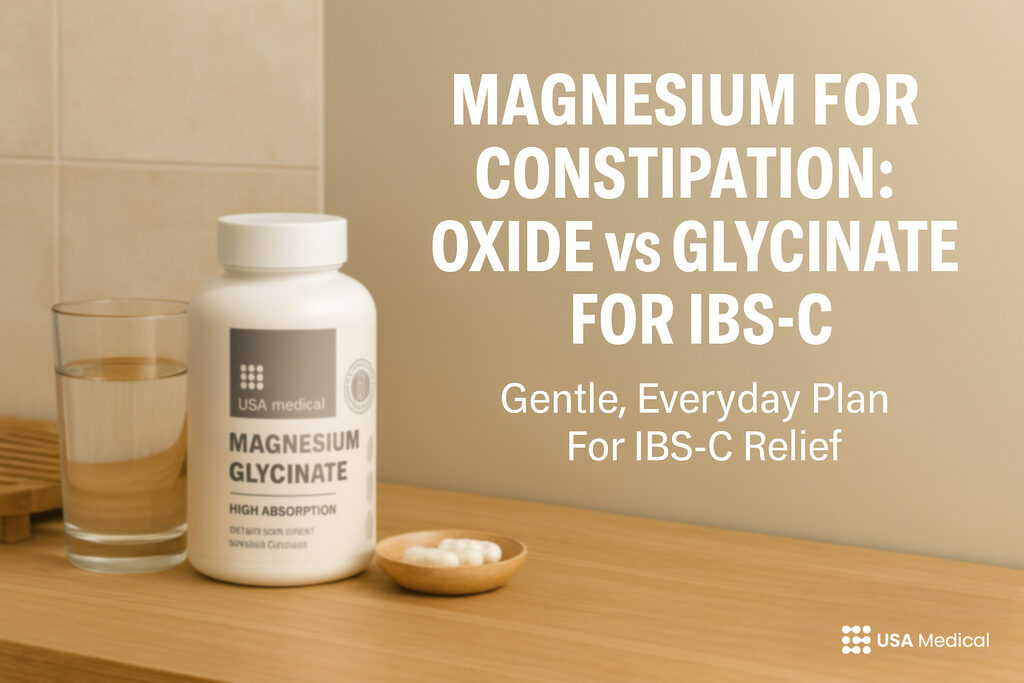
If your goal is comfortable, consistent relief, not a rollercoaster,

If you’re wondering whether magnesium glycinate for sleep is worth
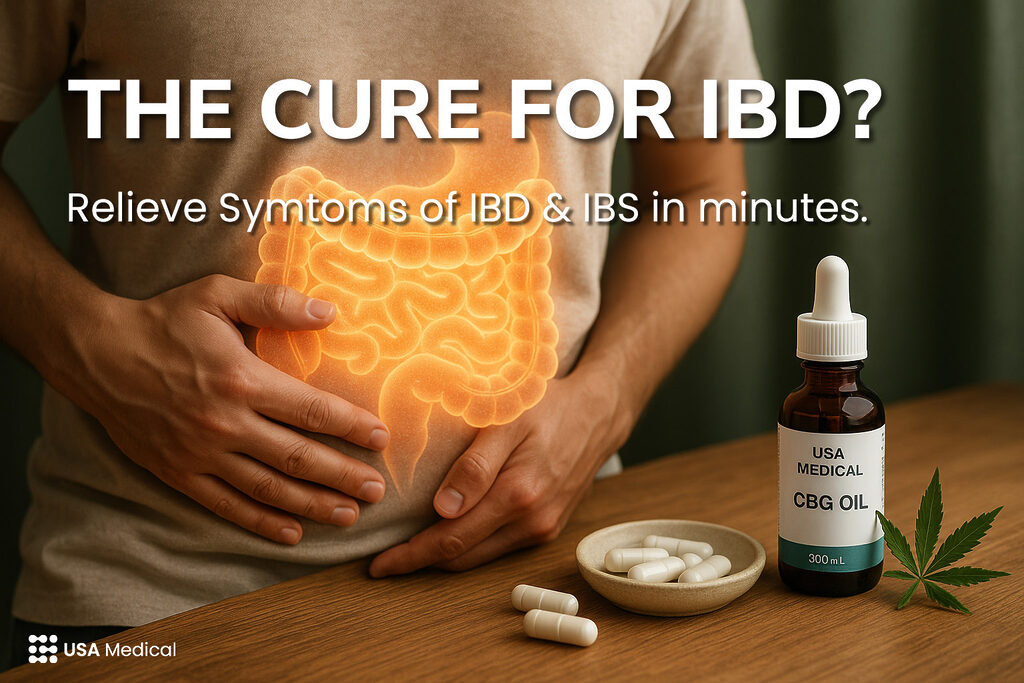
What we mean by IBD, IBS, and Crohn’s IBD is
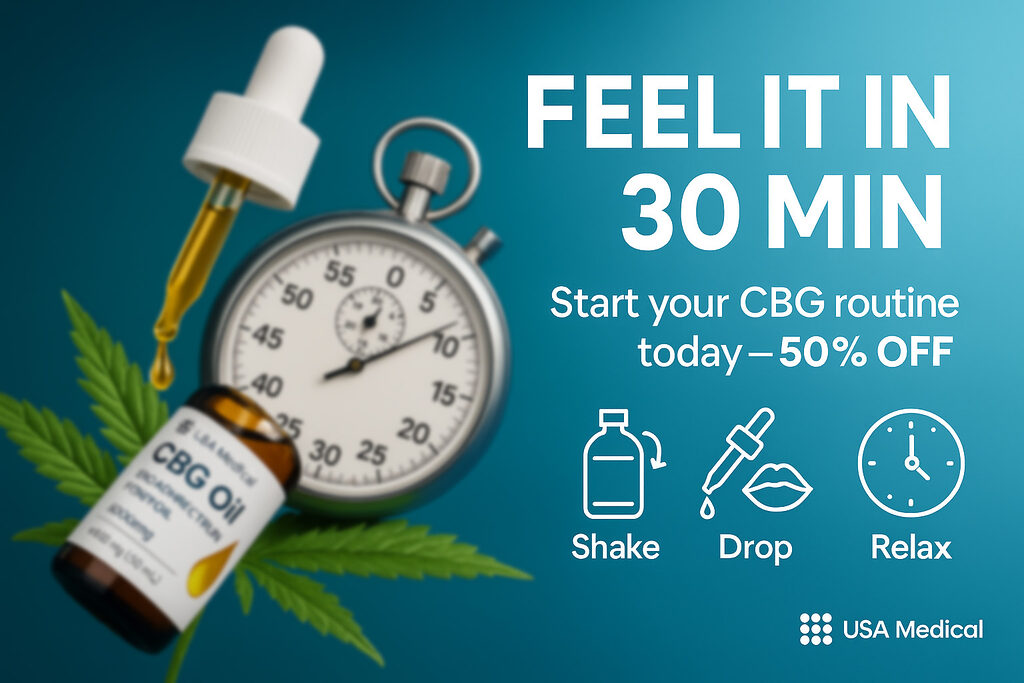
USA Medical CBG Oil works quickly and keeps working for
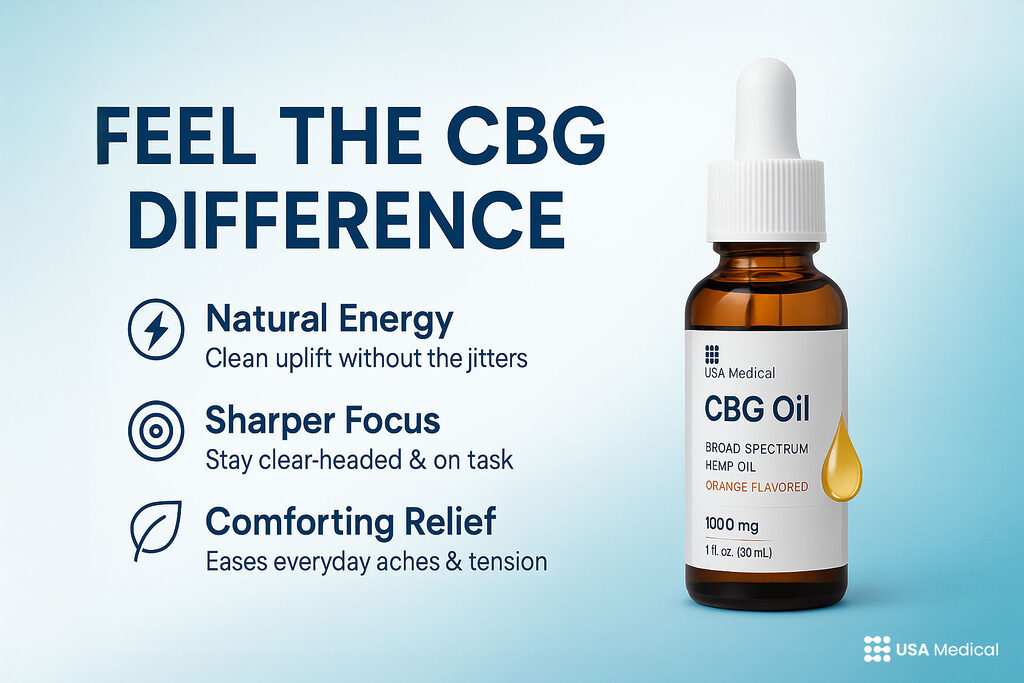
What Is CBG Oil? The Cannabinoid Behind the Buzz Cannabigerol
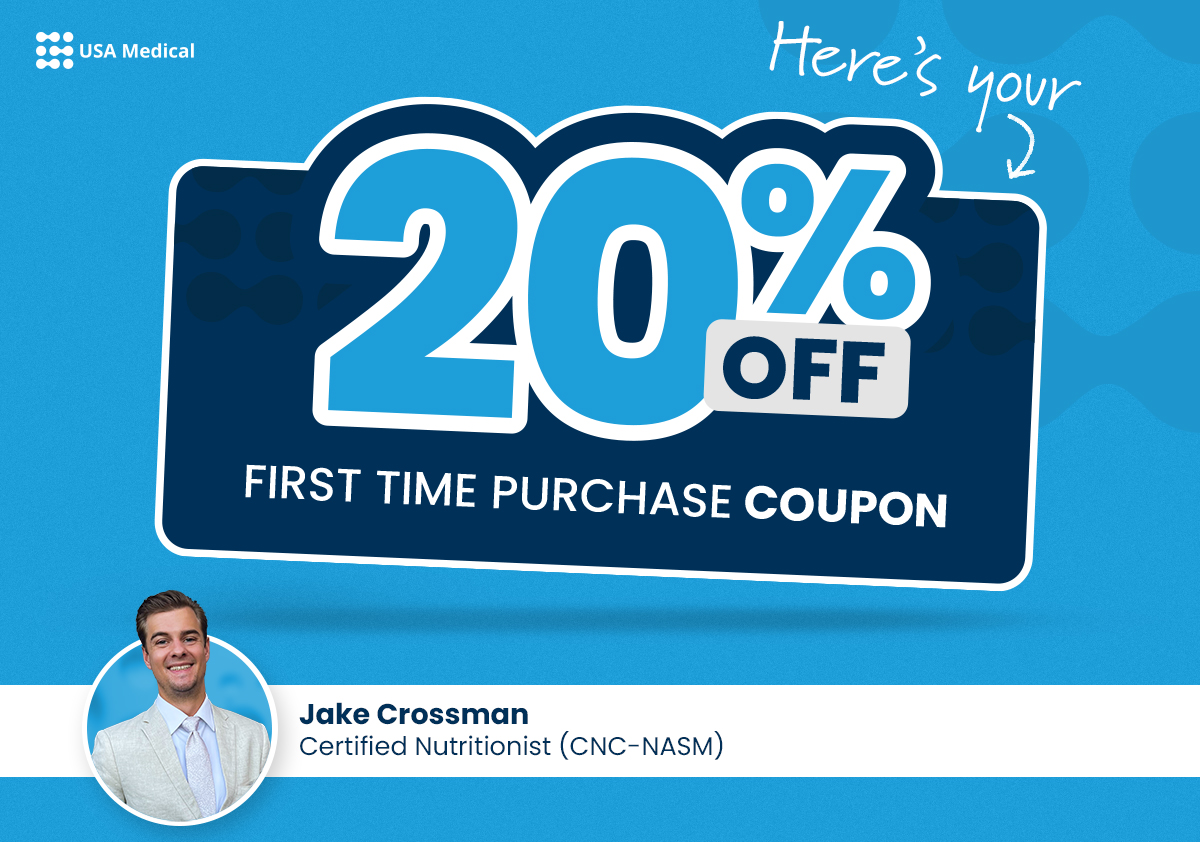
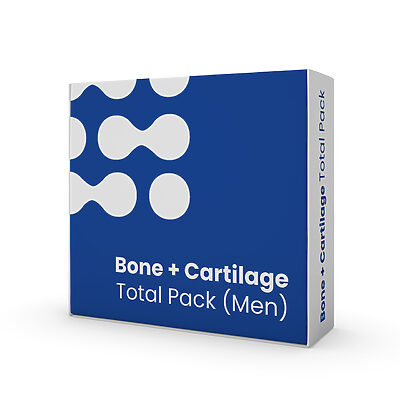
In stock | Free shipping
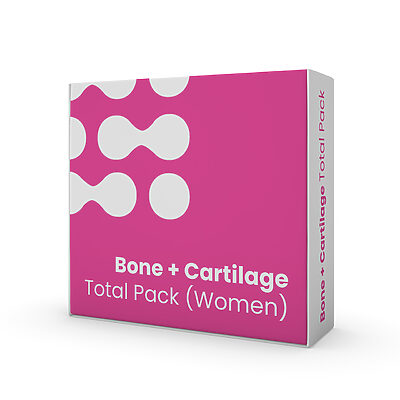
In stock | Free shipping
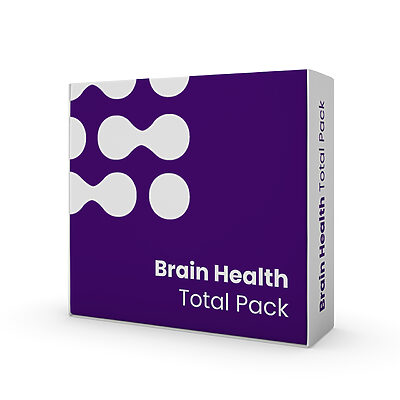
In stock | Free shipping
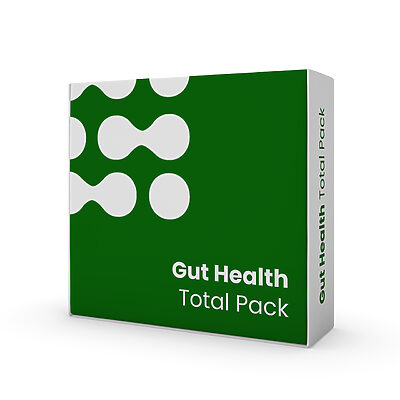
In stock | Free shipping
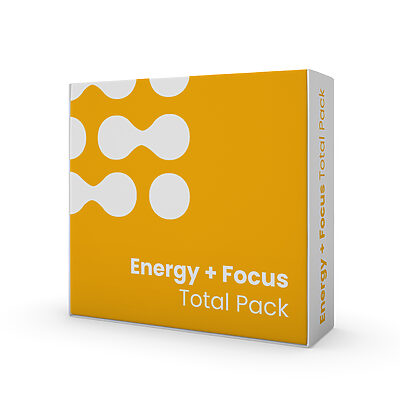
In stock | Free shipping
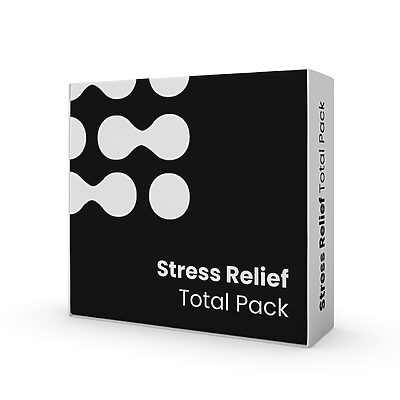
In stock | Free shipping
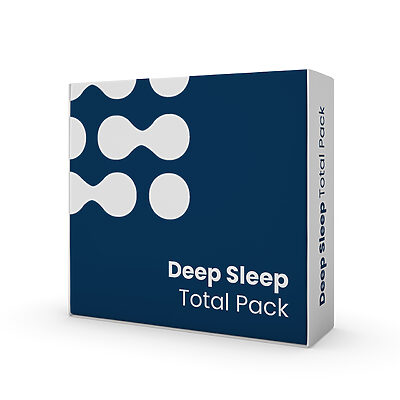
In stock | Free shipping
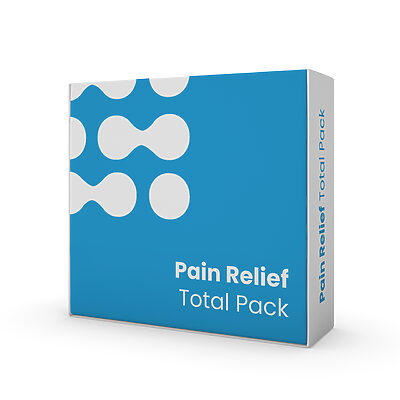
In stock | Free shipping